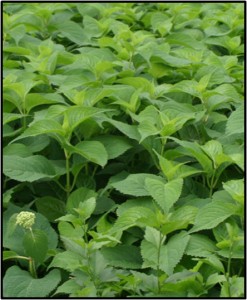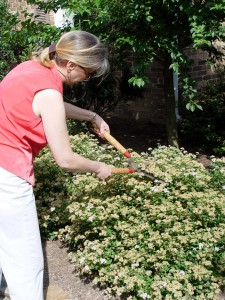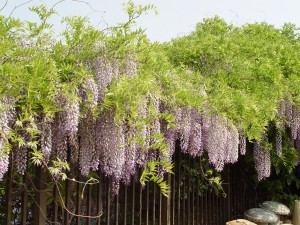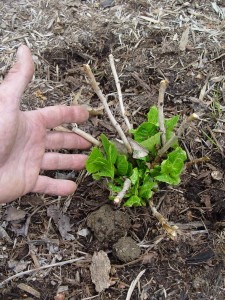Why Didn’t My Shrubs Bloom?
January 9th, 2012
One of the most aggravating non-events on the long list of Things That Go Wrong in the Garden is when flowering shrubs don’t flower.
That drives people nuts. After all, the flowers are the main reason we buy plants like lilacs, forsythia, hydrangeas and weigela.
Thankfully, most of the time these shrubs do flower. But sometimes, the shrub that flowered so profusely in past years is now barely putting out a blooming dribble.
Or that shrub that was flowering its head off in the garden-center pot is absolutely refusing to cough up so much as a bud in your garden.
Or maybe it’s that wisteria that was literally dripping flowers in the catalog photo is churning out nothing more than twining green branches and annoying roots in real life.
There are a lot of potential explanations for these non-performances.
Dr. Jim Sellmer, assistant professor of ornamental horticulture at the Pennsylvania State University, has fielded his share of calls about this, and he says bloom-deprived gardeners are usually “concerned, confused and wondering whether they had done something to cause the problem.”
In many cases, the answer is yes, they really DID unwittingly do something wrong. “Operator error” is at the heart of many a missing bloom.
One of the most common mistakes is pruning off the flower buds before they’ve had a chance to open.
This happens most often with the early spring-flowering shrubs such as forsythia, azalea and flowering almond, which form their flower buds the fall before.
“By February or March, many people are tired of being inside, and they heard once that then is a good time to prune,” says Sellmer.
While late-winter pruning is fine for evergreens and summer-flowering shrubs, it’s NOT fine for spring bloomers. If you prune these heavily, you might whack off every last one of their flower-buds-in-waiting.
“The best advice is to know when your plants flower,” says Sellmer. “A general rule of thumb is spring-flowering plants (ones that bloom March through June) should be pruned right AFTER flowering. Summer-flowering plants (ones that bloom July through fall) should be pruned in the dormant season or just before spring growth starts.” (See the list below for specifics.)
Also high on the operator-error list is putting the wrong plant in the wrong place – usually in too much shade. Some plants will bloom in part shade, some really need full sun and only a few will bloom in deep shade.
“Get to know the requirements of your plants before you buy them and place them in the landscape,” says Sellmer. “If the tag or one of the many references that are available say full sun is the right location, heed that and put them in full sun.”
Occasionally plants get “blind-sided” by sites that used to be full sun but are now shaded because a nearby tree grew. That’s one clue to consider if you have a flowering shrub that used to bloom well but has been going downhill.
Sometimes we cause trouble by being TOO nice to our shrubs. Usually it boils down to over-fertilizing.
While it’s true that lack of phosphorus – the middle number of fertilizer labels – can be a factor in poor blooming, it’s equally true that too much nitrogen (the first number) can cause overly lush foliage at the expense of flowers.
One way to screw up your plant’s nutrition is by over-using a fertilizer high in nitrogen. Most lawn fertilizers are very high in nitrogen, so if you’re putting down four applications of that right next to your shrub beds, you could be hurting your shrub flowers while you help your grass.
It’s also possible to overdo the nitrogen by repeated use of balanced fertilizers – ones that have equal or nearly equal amounts of nitrogen, phosphorus and potassium (the third key plant nutrient).
Sellmer says he cringes when he sees ads that liquid fertilizer companies run encouraging gardeners to regularly apply fertilizer.
“You can keep a plant in a continuous vegetative state by hitting it too often with high-nitrogen fertilizers or too much of a balanced fertilizer too often,” he says. “We fall into the trap that more is better.”
Sellmer says one sign of too much nitrogen is looking at the branches to see how much distance there is between the leaf stems. If there is a lot of distance and if the branches are weak and “leggy,” that could be a sign that you’re overdoing it.
He also suggests a soil test so you won’t be guessing what product to add and how often.
If it turns out that out-of-whack soil nutrition is your main problem, it’s going to take some time to return it to balance. There is no Viagra for plants to get them producing immediately.
“Follow the recommendations that come back with the (soil) test and be patient,” says Sellmer. “Buy some annuals to intermix with the shrubs to give you that flash of color you’re dying for until your plants start blooming.”
Age is another reason for non-bloom. While a lot of shrubs will start blooming within a year or two of being planted, some need more. Hydrangeas may not bloom until their third season, and wisteria and trumpet vines are notorious for going five to seven years before they bloom for the first time.
Shrubs that have been moved also fall into this category. It may take a year or two for a transplanted shrub to get used to its new home and begin flowering again.
“Being dug up is a traumatic experience,” says Sellmer. “When you cut a plant’s roots, it starts trying to re-establish the natural balance between the roots and shoots. It will take time to re-establish, which requires significant energy and time… The plant’s growth rate will be challenged, and flowering will not be its first priority.
“Flowers are very expensive, in terms of energy, for a plant to produce and maintain. When under stress, most often the energy is directed toward solving the imbalance in the system.”
Transplanting isn’t the only stress that can lead to poor or no flowering. Planting shrubs too deeply, in the wrong light, in poor soil or in too-damp or too-dry sites are stresses, too. So are bugs, disease, rodent damage, air pollution, road salt and other environmental problems.
“Basically any stress that is put on a plant can hinder flowering,” says Sellmer.
The solution here is to do a little police work, look for cultural and environmental problems, correct as many of the wrongs as you can, and then give the plant a chance to bounce back.
Sometimes it’s not one big thing going wrong but a combination of these “smaller” things.
While pruning at the wrong time is one of those big things, not pruning at all might explain why a former star bloomer is now petering out.
Many flowering shrubs bloom best on fairly young wood – branches that are one to three years old. As branches age, they flower less and may even stop flowering at some point. If these aren’t removed to make way for young growth, the whole show starts going down the tubes.
Lilacs and mock orange are prime examples of this phenomenon. The solution is to remove about a third of the oldest growth each year so there’s always a steady supply of new growth hitting prime blooming time.
One other factor that sometimes plagues early-spring bloomers is a heavy-duty late frost. Those buds that formed the fall before might be killed by the cold just as they were getting ready to open, turning them into little mushy brown blobs instead of beautiful flowers.
If all else fails, some shrubs (especially wisteria) respond to the rather drastic action of root pruning – severing about half of the plant’s roots about a foot out from the trunk. The theory is that the plant “thinks” its life might be endangered so it quickly tries to produce flowers in one last effort to procreate itself with the ensuing seed or pollen.
Sellmer thinks that if you get to that point, you’re probably better off trying another plant.
“There are too many plants available for the landscape for a wide variety of sites to limit yourself to this plant in this situation,” he says.
So go ahead and yank out the rebels if they don’t respond to your coaxing. That alluring little abelia in the white pot probably will be a lot more grateful anyway.
* Shrubs that are best pruned in winter or early spring before new growth starts: abelia, arborvitae, barberry, beautyberry, boxwood, burning bush, butterfly bush, chastebush (vitex), clematis (summer-blooming varieties), crape myrtle, euonymus, heather, holly, honeysuckle, hydrangea (summer-blooming varieties), potentilla, pyracantha, roses, rose of sharon, snowberry, St. John’s wort, spirea (Bumald and Japanese types), summersweet, Virginia sweetspire.
* Shrubs that are best pruned immediately AFTER they’ve bloomed: azalea, beautybush, bittersweet, clematis (spring-blooming varieties), cotoneaster, deutzia, dogwood, enkianthus, flowering almond, forsythia, heath, kerria, lilac, magnolia, mahonia, mock orange, mountain laurel, ninebark, pieris, quince, rhododendron, spicebush, sweetshrub, viburnum, weigela, witch hazel, wisteria.
* Sidebar: Why didn’t my hollies get berries?
A similar problem to no-flowering shrubs is why hollies sometimes don’t get berries.
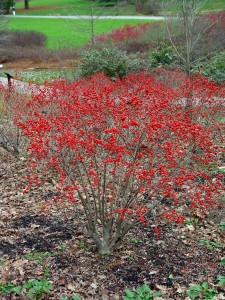
- A winterberry holly won’t get this kind of berry set without a good male nearby whose bloom time overlaps the female.
Hollies are plants that come in male and female types. Although both types flower, it is the female plants that get the berries.
Females need a suitable male nearby (usually within 100 feet is fine) to provide the pollen needed to produce the berries. Without it, the female flowers will dry and drop off.
“Having flowers is only half the job,” says Dr. Jim Sellmer, assistant professor of ornamental horticulture at the Pennsylvania State University. “Having a pollinator – primarily bees – is also required. Watch your use of pesticides such as Sevin around flowering time. Bees are highly susceptible.”
Sellmer also advises planting other flowers that bloom at the same time as hollies to provide other pollen sources to help attract bees.
It’s also important to match males and females well. Hollies of different species do not cross-pollinate very well, so if you’re planting blue hollies, for example, make sure both the males and females are blue hollies.
The males and females also must be in bloom at the same time. That’s something that frequently goes wrong with winterberry hollies, the smooth-leafed types that drop their leaves in winter.
Some winterberry types bloom early and some bloom later. If you pick an early male and a late female, the bloom times might not overlap and pollination won’t occur.
Usually, nursery signs will tell you which males go with which females. If it’s not listed, ask before buying.
Sometimes the variety names make it easy to match-make. For example, ‘Blue Prince’ holly is a perfect mate for ‘Blue Princess,’ ‘China Boy’ goes with ‘China Girl’ and ‘Blue Boy’ goes with ‘Blue Girl.’
One male is usually enough to produce fruit on up to 20 females, so long as he is within 100 feet of them and there are adequate bees.
One other berry-stopping possibility is a late spring frost. If a sudden cold snap occurs when the holly flowers are opening, it may be enough to kill them before pollination and fruit setting take place.








